Land Damage Mapping and Liquefaction Potential Analysis of Soils from the Epicentral Region of 2017 Pohang Mw 5.4 Earthquake, South Korea
Abstract
1. Introduction
2. Geological Settings
3. 2017 Pohang Earthquake and Observed Liquefaction Features
4. Liquefaction Potential Analysis of Soils from the Epicentral Areas of the 2017 Pohang Earthquake
4.1. Ground Motion Data
4.2. Site Investigation and Liquefaction Assessment
4.3. Result of Selected SPT in the Heunghae Basin
4.4. SPT Based Liquefaction Potential Assessment
4.4.1. Estimation of Cyclic Stress Ratio (CSR)
4.4.2. Estimation of Cyclic Resistance Ratio
4.4.3. Correction for SPT-N Blow Count
4.4.4. Factor of Safety against Liquefaction (FSL)
4.4.5. Assessment of Liquefaction Potential Index
4.4.6. Post Liquefaction Settlement Estimation
5. Liquefaction Analysis
6. Results and Discussion
7. Conclusions
- The liquefaction triggered during the Mw 5.4 Pohang earthquake was localized and observed more in the southern part than the northern part of the basin. This may be due to the basin geometry, presence of the Heunghae fault at the center of the basin and the locality lying between the Gokgang River and the Chogok River with a shallow water table.
- On the basis of land damage distribution, most of the damaged lands are categorized as moderate to major land damage and confined between the Gokgang and Chogok Rivers.
- The grain size analysis of the ejected soil suggests that the soils are silty sand, sand with gravel, and sandy soil, which falls in the range of most liquefied soils reported in the literature.
- A 10.5 km long profile was chosen to determine the liquefaction potential, LPI, post-liquefaction settlement along the southern part of the basin, using SPT-N data and the Pohang earthquake ground motion data recorded at PHN2 station. The analysis indicates that the silty soil, silty sand, and sandy soil from 1.5 to 15 m deep are prone to liquefaction.
- Liquefaction susceptibility of the soil based on SPT-N value showed that the soils from 1.5 to 15 m possess FSL values from 0.2 to 1.0. The liquefaction potential index (IL) estimated for the boreholes suggests that the southern part of the Heunghae basin has a low to high liquefaction potential index (IL) values ranging from 2 to 19, which complements with the field evidence of sand boils during the earthquake.
- From the post liquefaction settlement, the soils having FSL values lower than 1 show maximum post-liquefaction settlement ranging from 6 to 50 cm.
- This study suggests that the soils of the Heunghae basin are prone to liquefaction for earthquakes higher than Mw 5.4 and more comprehensive geotechnical investigations are required for better estimation of liquefiable soil depth along with the preparation of liquefaction hazard zonation maps.
- Similar liquefaction potential analysis must be carried out for other basins situated in close proximity to the Yangsan and Ulsan faults, including the Pohang basin, a major industrial center along the SE Korean Peninsula. This study will support the national disaster management authorities in developing a sustainable guideline for liquefaction hazard mitigation.
Author Contributions
Funding
Acknowledgments
Conflicts of Interest
List of Symbols
| SPT-N | Standard Penetration Test |
| CPT | Cone penetration Test |
| N | Number of blows |
| CSR | Cyclic Stress Ratio |
| CRR | Cyclic Resistance Ratio |
| MSF | Magnitude scaling factor |
| FSL | Factor of Safety against Liquefaction |
| amax | maximum acceleration |
| Vs30 | shear wave velocity at 30 m |
| PGA | Peak Ground Acceleration |
| LPI | Liquefaction Potential Index |
| LL | Liquid Limit |
| PI | Plasticity Index |
| KSF | Korean Industrial Standard |
| USCS | Unified Soil Classification System |
| ASTM | American Standard for Testing Materials |
| PHN | POSEIDON seismic station at Pohang |
| NZS | New Zealand design Standards |
| NCEER | National Center for Earthquake Engineering Research |
References
- Seed, B. Soil Liquefaction and Cyclic Mobility Evalution for Level Ground during Earthquakes. J. Geotech. Geoenv. Eng. 1979, 105, 14380. [Google Scholar]
- Leeder, M.R. Soft sediment deformation structures. In Sedimentology; Springer: Berlin/Heidelberg, Germany, 1982; pp. 111–116. [Google Scholar]
- Bates, R.L.; Jackson, J.A. Glossary of Geology; American Geological Institute: Alexandria, VA, USA, 1984; p. 788. [Google Scholar]
- Marcuson, W.F.; Franklin, A.G. State of the Art of Undisturbed Sampling of Cohesionless Soils; US Army Engineer Waterways Experiment Station: Vicksburg, MS, USA, 1979. [Google Scholar]
- Youd, T.L.; Idriss, I.M. Liquefaction resistance of soils: Summary report from the 1996 NCEER and 1998 NCEER/NSF workshops on evaluation of liquefaction resistance of soils. J. Geotech. Geo. Eng. 2001, 127, 297–313. [Google Scholar] [CrossRef]
- Youd, T.L.; Perkins, D.M. Mapping liquefaction-induced ground failure potential. J. Soil Mech. Found. Div. 1978, 104, 433–446. [Google Scholar]
- Marto, A.; Tan, C.S. Short review on liquefaction susceptibility. Int. J. Eng. Res. Appl. 2012, 2, 2115–2119. [Google Scholar]
- Seed, H.B.; Lee, K.L. Liquefaction of Saturated Sands during Cyclic Loading. J. Soil Mech. Found. 1966, 92, 105–134. [Google Scholar]
- Yoshimi, Y.; Tokimatsu, K.; Kaneko, O.; Makihara, Y. Undrained Cyclic Shear Strength of Dense Nigata Sand. Soils Found. 1984, 24, 131–145. [Google Scholar] [CrossRef]
- Sladen, J.A.; D’Hollander, R.D.; Krahn, J. The Liquefaction of Sands, a Collapse Surface Approach. Can. Geotech. J. 1985, 22, 564–578. [Google Scholar] [CrossRef]
- Yamamuro, J.A.; Covert, K.M. Monotonic and cyclic liquefaction of very loose sands with high silt content. J. Geotech. Geo. Eng. 2001, 127, 314–324. [Google Scholar] [CrossRef]
- Hushmand, B.; Scott, R.F.; Crouse, C.B. Centrifuge liquefaction tests in a laminar box. Geotechnique 1988, 38, 253–262. [Google Scholar] [CrossRef]
- Flora, A.; Lirer, S.; Silvestri, F. Undrained Cyclic Resistance of Undisturbed Gravelly Soil. Soil Dyn. Earthq. Eng. 2012, 43, 366–379. [Google Scholar] [CrossRef]
- Lentini, V.; Castelli, F. Liquefaction Resistance of Sandy Soils from Undrained Cyclic Triaxial Tests. Geotech. Geol. Eng. 2019, 37, 201. [Google Scholar] [CrossRef]
- Seed, R.B.; Michael, F.R.; Stephen, E.D. Liquefaction of Soils in the 1989 Loma Prieta Earthquake. In Proceedings of the 1991 International Conferences on Recent Advances in Geotechnical Earthquake Engineering and Soil Dynamics, St. Louis, MO, USA, 17 October 1989. [Google Scholar]
- Bardet, J.P.; Kapuskar, M. Liquefaction sand boils in San Francisco during 1989 Loma Prieta earthquake. J. Geotech. Eng. 1993, 119, 543–562. [Google Scholar] [CrossRef]
- Elgamal, A.W.; Zeghal, M.; Parra, E. Liquefaction of reclaimed island in Kobe, Japan. J. Geotech. Eng. 1996, 122, 39–49. [Google Scholar] [CrossRef]
- Tokimatsu, K.; Mizuno, H.; Kakurai, M. Building damage associated with geotechnical problems. Soils Found. 1996, 36, 219–234. [Google Scholar] [CrossRef]
- Van Ballegooy, S.; Malan, P.; Lacrosse, V.; Jacka, M.E.; Cubrinovski, M.; Bray, J.D.; O’Rourke, T.D.; Crawford, S.A.; Cowan, H. Assessment of liquefaction-induced land damage for residential Christchurch. Earthq. Spectra 2014, 30, 31–55. [Google Scholar] [CrossRef]
- Cubrinovski, M.; Bray, J.D.; Taylor, M.; Giorgini, S.; Bradley, B.; Wotherspoon, L.; Zupan, J. Soil liquefaction effects in the central business district during the February 2011 Christchurch earthquake. Seismol. Res. Lett. 2011, 82, 893–904. [Google Scholar] [CrossRef]
- Mukunoki, T.; Kasama, K.; Murakami, S.; Ikemi, H.; Ishikura, R.; Fujikawa, T.; Yasufuku, N.; Kitazono, Y. Reconnaissance report on geotechnical damage caused by an earthquake with JMA seismic intensity 7 twice in 28 h, Kumamoto, Japan. Soils Found. 2016, 56, 947–964. [Google Scholar] [CrossRef]
- Widiyanto, W.; Santoso, P.B.; Hsiao, S.C.; Imananta, R.T. Post-event field survey of 28 September 2018 Sulawesi earthquake and tsunami. Nat. Hazards Earth Syst. Sci. 2019, 19, 2781–2794. [Google Scholar] [CrossRef]
- Paulik, R.; Gusman, A.; Williams, J.H.; Pratama, G.M.; Lin, S.L.; Prawirabhakti, A.; Sulendra, K.; Zachari, M.Y.; Fortuna, Z.E.D.; Layuk, N.B.P.; et al. Tsunami hazard and built environment damage observations from Palu City after the September 28 2018 Sulawesi earthquake and tsunami. Pure Appl. Geoph. 2019, 176, 3305–3321. [Google Scholar] [CrossRef]
- Scalen, K. Liquefaction and the law: Understanding challenges and failure to strengthen hazard management regulations. NZJ Envtl. L. 2016, 20, 279. [Google Scholar]
- Fan, X.; Juang, C.H.; Wasowski, J.; Huang, R.; Xu, Q.; Scaringi, G.; van Westen, C.J.; Havenith, H.B. What we have learned from the 2008 Wenchuan Earthquake and its aftermath: A decade of research and challenges. Eng. Geol. 2018, 241, 25–32. [Google Scholar] [CrossRef]
- Green, R.A.; Boomer, J.J. What is the smallest earthquake magnitude that needs to be considered in assessing liquefaction hazard? Earthq. Spectra 2019, 35, 1441–1464. [Google Scholar] [CrossRef]
- Ishihara, K. Liquefaction and flow failure during earthquakes. Geotechnique 1993, 43, 351–451. [Google Scholar] [CrossRef]
- Robertson, P.K. Suggested terminology for liquefaction. In Proceedings of the 47th Canadian Geotechnical Conference, Halifax, NS, Canada, 21–23 September 1994; pp. 277–286. [Google Scholar]
- Fukue, M.; Kawakami, T. Damage to man-made island caused by the 1995 Hogo-ken Nanbu earthquake. Mar. Geo. Geotech. 1996, 14, 237–250. [Google Scholar] [CrossRef]
- Tonkin and Taylor Limited. Darfield Earthquake 4 September 2010: Geotechnical Land Damage Assessment and Reinstatement Report, Stage 1 Report, Earthquake Commission; 2010. Available online: https://www.eqc.govt.nz/sites/public_files/t-t-stage1.pdf (accessed on 7 February 2020).
- Tonkin and Taylor Limited. Darfield Earthquake 4 September 2010: Geotechnical Land Damage Assessment and Reinstatement Report, Stage 2 Report, Earthquake Commission; 2010. Available online: https://www.eqc.govt.nz/sites/public_files/stage2-report.pdf (accessed on 7 February 2020).
- Orense, R.P.; Kiyota, T.; Yamada, S.; Cubrinovski, M.; Hosono, Y.; Okamura, M.; Yasuda, S. Comparison of liquefaction features observed during the 2010 and 2011 Canterbury earthquakes. Seismol. Res. Lett. 2011, 82, 905–918. [Google Scholar] [CrossRef]
- O’Rourke, T.D.; Jeon, S.S.; Toprak, S.; Cubrinovski, M.; Hughes, M.; van Ballegooy, S.; Bouziou, D. Earthquake response of underground pipeline networks in Christchurch, NZ. Earthq. Spectra 2014, 30, 183–204. [Google Scholar] [CrossRef]
- Van Ballegooy, S.; Malan, P.J.; Jacka, M.E.; Lacrosse, V.I.M.F.; Leeves, J.R.; Lyth, J.E.; Cowan, H. Methods for characterizing effects of liquefaction in terms of damage severity. In Proceedings of the 15th World Conference on Earthquake Engineering 2012 (15WCEE), Lisbon, Portugal, 24–28 September 2012; pp. 1–10. [Google Scholar]
- Mader, G.G.; Spangle, W.E.; Blair, M.L.; Meehan, R.L.; Bilodeau, S.W.; Degenkolb, H.J. Land Use Planning after Earthquakes; William Spangle and Associates: Parata Valley, CA, USA, 1980. [Google Scholar]
- Nakai, S.; Sachio, Y.; Akihiko, K. Interpreting ground conditions and earthquake damages based on the land use and its change. In Proceedings of the 12th World Conference on Earthquake Engineering, Auckland, New Zealand, 30 January–4 February 2000. [Google Scholar]
- Jacka, M.E.; Murahidy, K.M. Observation and characterisation of land damage due to liquefaction and lateral spreading. In Proceedings of the 9th Pacific Conference on Earthquake Engineering, Auckland, New Zealand, 14–16 April 2011. [Google Scholar]
- Iwasaki, T. A practical method for assessing soil liquefaction potential based on case studies at various sites in Japan. In Proceedings of the Second Int. Conf. Microzonation Safer Construction Research Application, San Francisco, CA, USA, 1978, 26 November 1978; Volume 2, pp. 885–896. [Google Scholar]
- Lai, C.G.; Bozzoni, F.; Mangriotis, M.D.; Martinelli, M. Soil liquefaction during the 20 may 2012 M5. 9 Emilia earthquake, northern Italy: Field reconnaissance and post-event assessment. Earthq. Spectra 2015, 31, 2351–2373. [Google Scholar] [CrossRef]
- Dobry, R. Liquefaction of soils during earthquakes. In National Research Council (NRC), Committee on Earthquake Engineering; Report No. CETS-EE-001; National Academy Press: Washington, DC, USA, 1985. [Google Scholar]
- Yilmaz, I.; Bagci, A. Soil liquefaction susceptibility and hazard mapping in the residential area of Kütahya (Turkey). Environ. Geol. 2006, 49, 708–719. [Google Scholar] [CrossRef]
- Ibrahim, K.M.H.I. Liquefaction analysis of alluvial soil deposits in Bedsa south west of Cairo. Ain Shams Eng. J. 2014, 5, 647–655. [Google Scholar] [CrossRef][Green Version]
- Sonmez, H. Modification of the liquefaction potential index and liquefaction susceptibility mapping for a liquefaction-prone area (Inegol, Turkey). Environ. Geol. 2003, 44, 862–871. [Google Scholar] [CrossRef]
- Lenz, J.A.; Laurie, G.B. Spatial variability of liquefaction potential in regional mapping using CPT and SPT data. Soil Dyn. Earthq. Eng. 2007, 27, 690–702. [Google Scholar] [CrossRef]
- Papathanassiou, G. LPI-based approach for calibrating the severity of liquefaction-induced failures and for assessing the probability of liquefaction surface evidence. Eng. Geol. 2008, 96, 94–104. [Google Scholar] [CrossRef]
- Papathanassiou, G.; Mantovani, A.; Tarabusi, G.; Rapti, D.; Caputo, R. Assessment of liquefaction potential for two liquefaction prone areas considering the May 20, 2012 Emilia (Italy) earthquake. Eng. Geol. 2015, 189, 1–16. [Google Scholar] [CrossRef]
- Naik, S.P.; Kim, Y.S.; Kim, T.; Su-Ho, J. Geological and Structural Control on Localized Ground Effects within the Heunghae Basin during the Pohang Earthquake (MW 5.4, 15th November 2017), South Korea. Geosciences 2019, 9, 173. [Google Scholar] [CrossRef]
- Gihm, Y.S.; Kim, S.W.; Ko, K.; Choi, J.H.; Bae, H.; Hong, P.S.; Lee, Y.; Lee, H.; Jin, K.; Choi, S.J.; et al. Paleoseismological implications of liquefaction-induced structures caused by the 2017 Pohang earthquake. Geosci. J. 2018, 6, 871–880. [Google Scholar] [CrossRef]
- Choi, J.H.; Ko, K.; Gihm, Y.S.; Cho, C.S.; Lee, H.; Song, S.G.; Bang, E.S.; Lee, H.J.; Bae, H.K.; Kim, S.W.; et al. Surface Deformations and Rupture Processes Associated with the 2017 M w 5.4 Pohang, Korea, Earthquake. Bull. Seismol. Soc. Am. 2019, 109, 756–769. [Google Scholar] [CrossRef]
- Kang, S.; Kim, B.; Bae, S.; Lee, H.; Kim, M. Earthquake-Induced Ground Deformations in the Low-Seismicity Region: A Case of the 2017 M5. 4 Pohang, South Korea, Earthquake. Earthq. Spectra 2019, 35, 1235–1260. [Google Scholar] [CrossRef]
- Choi, J.H.; Kim, Y.S.; Choi, S.J. Identification of a suspected Quaternary fault in eastern Korea: Proposal for a paleoseismic research procedure for the mapping of active faults in Korea. J. Asia Earth Sci. 2015, 113, 897–908. [Google Scholar] [CrossRef]
- Yoon, S.H.; Sohn, Y.K.; Chough, S.K. Tectonic, sedimentary, and volcanic evolution of a back-arc basin in the East Sea (Sea of Japan). Mar. Geol. 2014, 352, 70–88. [Google Scholar] [CrossRef]
- Kee, W.S.; Kihm, Y.H.; Lee, H.; Cho, D.L.; Kim, B.C.; Song, K.Y.; Koh, H.J.; Lee, S.R.; Yeon, Y.K.; Hwang, S.; et al. Evaluation and database construction of Quaternary faults in SE Korea. Korea Inst. Geosci. Miner. Resour. 2009, 1, 327. (In Korean) [Google Scholar]
- Chang, C.J.; Chang, T.W. Behavioral Characteristics of the Yangsan Fault based on Geometric Analysis of Fault Slip. J. Eng. Geol. 2009, 19, 277–285. [Google Scholar]
- Jun, M.S.; Jeon, J.S. Focal mechanism in and around the Korean Peninsula. Geophys. Geophys. Explor. 2010, 13, 198–202. [Google Scholar]
- Son, M.; Song, C.W.; Kim, M.C.; Cheon, Y.; Cho, H.; Sohn, Y.K. Miocene tectonic evolution of the basins and fault systems, SE Korea: Dextral, simple shear during the East Sea (Sea of Japan) opening. J. Geol. Soc. 2015, 172, 664–680. [Google Scholar] [CrossRef]
- Korean Meteorological Administration. KMA Report on Pohang Earthquake (Korean); Korean Meteorological Administration: Seoul, Korea, 2018; pp. 1–41. [Google Scholar]
- American Society for Testing and Materials. Committee D18 on Soil and Rock. In Standard Test Methods for Particle-Size Distribution (Gradation) of Soils Using Sieve Analysis; ASTM International: West Conshohocken, PA, USA, 2004. [Google Scholar]
- Tsuchida, H.; Hayashi, S. Estimation of Liquefaction Potential of Sandy Soils; Publication of Mcgraw Hill Book Company: New York, NY, USA, 1972. [Google Scholar]
- Park, S.S.; Nong, Z.; Choi, S.G.; Moon, H.D. Liquefaction Resistance of Pohang Sand. J. Korea Geotech. Soc. 2018, 34, 5–17. [Google Scholar]
- NZGS 2010. Guidelines for Geotechnical Earthquake Engineering Practice in New Zealand. In Module 1—Guideline for the Identification, Assessment and Mitigation of Liquefaction Hazards; New Zealand Geotechnical Society: Wellington, New Zealand, 2010. [Google Scholar]
- Integrated DB Center of National Geotechnical Information. Available online: http://www.geoinfo.or.kr (accessed on 5 February 2020).
- KSF 2307. Test. Method for Standard Penetration. Korean Industrial Standards. Available online: https://infostore.saiglobal.com/en-us/standards/ks-f23072007655646_SAIG_KSA_KSA_1503420/ (accessed on 7 February 2020).
- A.S.T.M., D1586-11. ASTM D1586-11 Standard Test. Method for Standard Penetration Test. (SPT) and Split-Barrel Sampling of Soils, ASTM International, West. Conshohocken, PA. 2011. Available online: https://www.astm.org/Standards/D1586.htm (accessed on 7 February 2020).
- Naik, S.P.; Patra, N.R.; Malik, J.N. Assessment of liquefaction potential of alluvial soil of Indo-Gangetic Interfluves, Northern India. In Proceedings of the GeoCongress 2012; Oakland, CA, USA, 25–29 March 2012, pp. 1859–1868.
- Naik, S.P.; Patra, N.R. Generation of Liquefaction Potential Map for Kanpur City and Allahabad City of Northern India: An Attempt for Liquefaction Hazard Assessment. Geotech. Geol. Eng. 2018, 36, 293–305. [Google Scholar] [CrossRef]
- Naik, S.P.; Kundu, A.; Patra, N.R.; Bandopadhaya, S.; Reddy, G.R. Earthquake Response Analysis of Soils from Rudrapur and Khatima Sites Adjacent to Himalayan Frontal Thrust (HFT) using Field and Laboratory-Derived Dynamic Soil Properties. J. Earthq. Eng. 2019, 1–31. [Google Scholar] [CrossRef]
- Ansal, A.; Tönük, G. Source and site factors in microzonation. In Earthquake Geotechnical Engineering; Springer: Berlin/Heidelberg, Germany, 2007; pp. 73–92. [Google Scholar]
- Seed, H.B.; Idriss, I.M. Simplified procedure for evaluating soil liquefaction potential. J. Soil Mech. Found. Div. ASCE 1971, 97, 1249–1273. [Google Scholar]
- Seed, H.B. Earthquake Resistant Design of Earth Dam. In Proceedings of symposium on seismic design of embankment and caverns, Philadelphia; ASCE: New York, NY, USA, 1983; pp. 41–64. [Google Scholar]
- Zhang, G.; Robertson, P.K.; Brachman, R.W.I. Estimating liquefaction-induced lateral displacements using the standard penetration test or cone penetration test. J. Geotech. Geoenviron. Eng. 2004, 130, 861–871. [Google Scholar] [CrossRef]
- Blake, T.F. Formula (4), Summary Report of Proceedings of the NCEER Workshop on Evaluation of Liquefaction Resistance of Soils; Youd, T.L., Idriss, I.M., Eds.; Technical Report NCEER 97-0022; Temple Square: Salt Lake City, UT, USA, 1997. [Google Scholar]
- Cetin, K.O.; Seed, R.B.; Kiureghian, A.D.; Tokimatsu, K.; Harder, L.F.; Kayen, R.E.; Moss, R.E.S. Standard penetration test-based probabilistic and deterministic assessment of seismic soil liquefaction potential. J. Geotech. Geoenviron. Eng. ASCE 2004, 130, 1314–1340. [Google Scholar] [CrossRef]
- Idriss, I.M.; Boulanger, R.W. SPT-Based Liquefaction Triggering Procedures; Report UCD/CGM-10/02; Department of Civil and Environmental Engineering; University of California: Davis, CA, USA, 2010. [Google Scholar]
- Luna, R.; Frost, J.D. Spatial liquefaction analysis system. J. Comput. Civ. Eng. 1998, 12, 48–56. [Google Scholar] [CrossRef]
- Lenz, J.; Baise, L.G. Variability of LPI across geologic units for regional liquefaction mapping. Dyn. Response Soil Prop. 2007. [Google Scholar]
- Dixit, J.; Dewaikar, D.M.; Jangid, R.S. Assessment of liquefaction potential index for Mumbai city. Nat. Hazards Earth Syst. Sci. 2012, 12, 2759–2768. [Google Scholar] [CrossRef]
- Tokimatsu, K.; Seed, H.B. Evaluation of settlements in sands due to earthquake shaking. J. Geotech. Eng. 1987, 113, 861–878. [Google Scholar] [CrossRef]
- Ishihara, K.; Yoshimine, M. Evaluation of settlements in sand deposits following liquefaction during earthquakes. Soils Found 1992, 32, 173–188. [Google Scholar] [CrossRef]
- Jishnu, R.B.; Naik, S.P.; Patra, N.R.; Malik, J.N. Ground response analysis of Kanpur soil along Indo-Gangetic Plains. Soil Dyn. Earthq. Eng. 2013, 51, 47–57. [Google Scholar] [CrossRef]
- NovoLiq software, Programming Alireza Afkham Designed for Soil Liquefaction Analysis during Earthquake, First Released on September 2009. Address: 4188 Hoskins Road, North Vancouver, BC, Canada. Available online: https://novotechsoftware.com/geotechnical-software/soil-liquefaction-software/ (accessed on 20 December 2019).
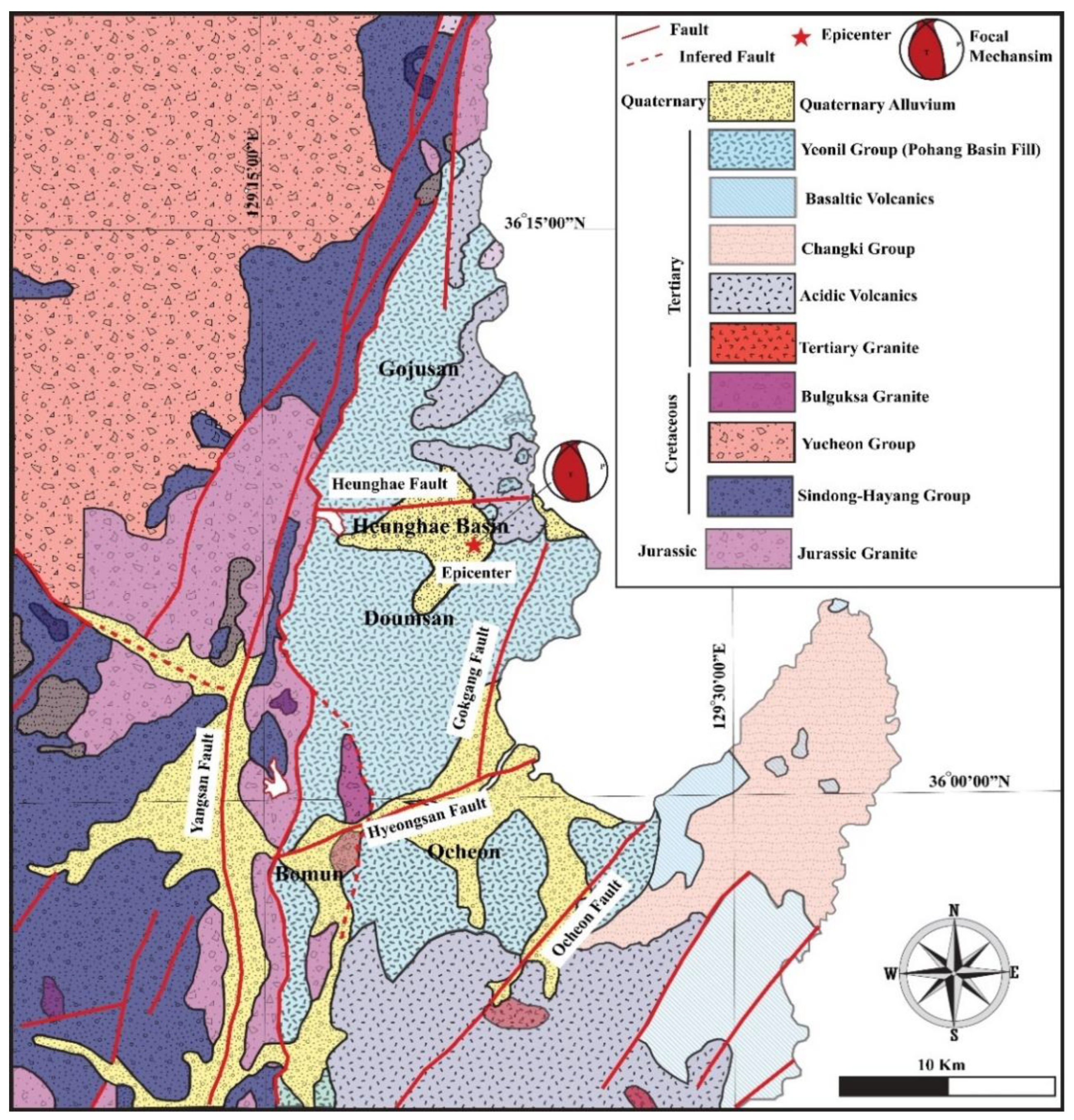
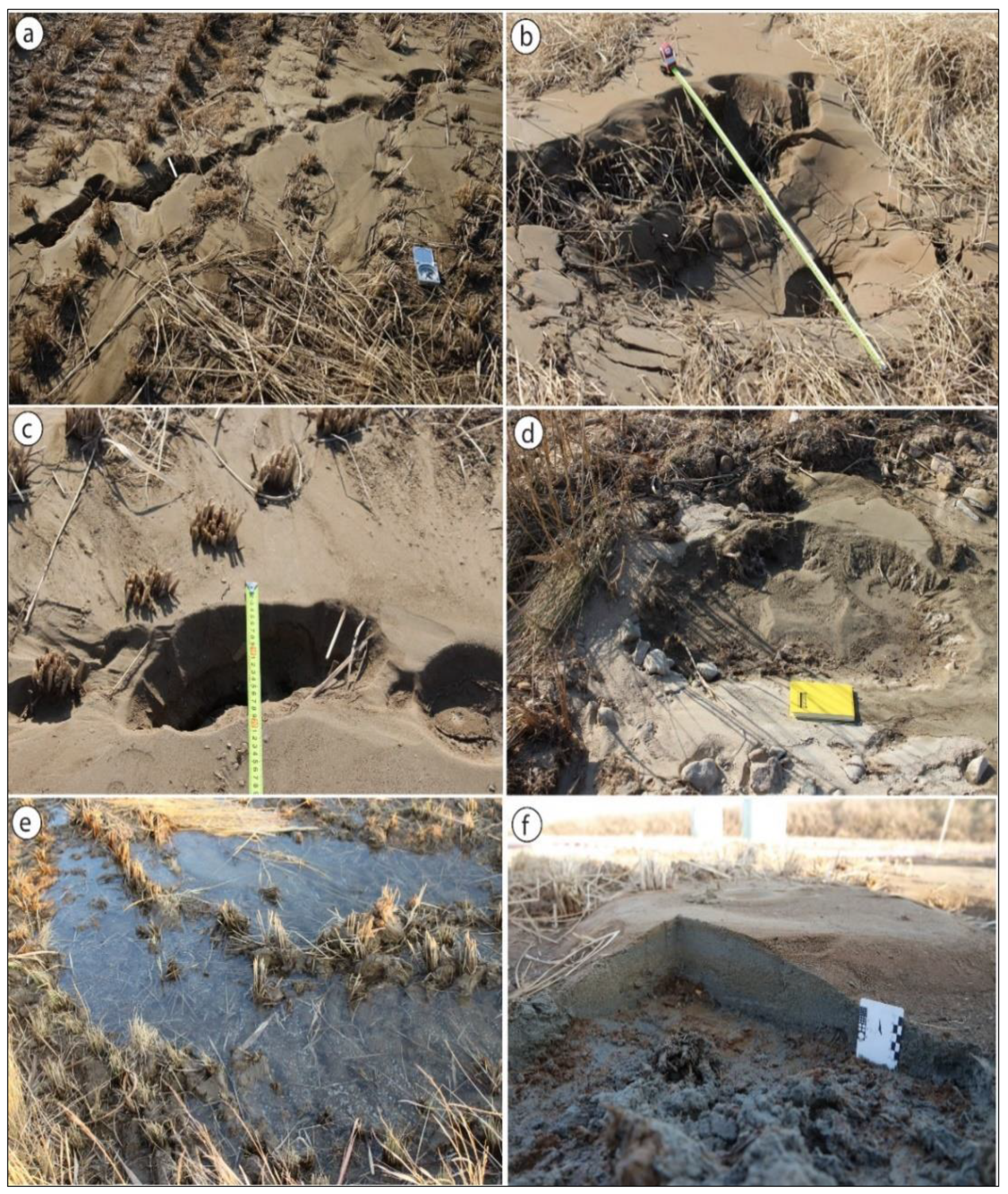
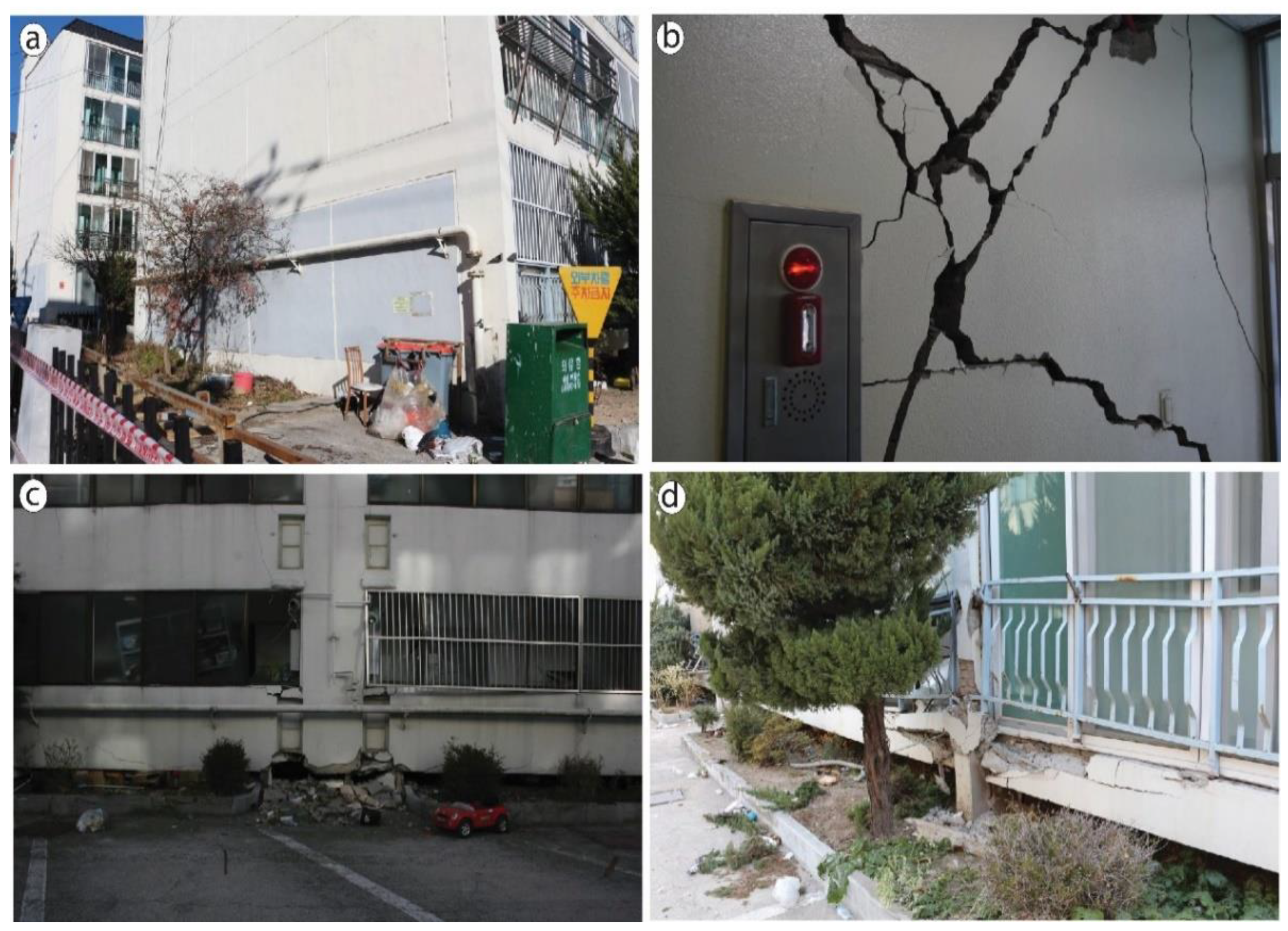
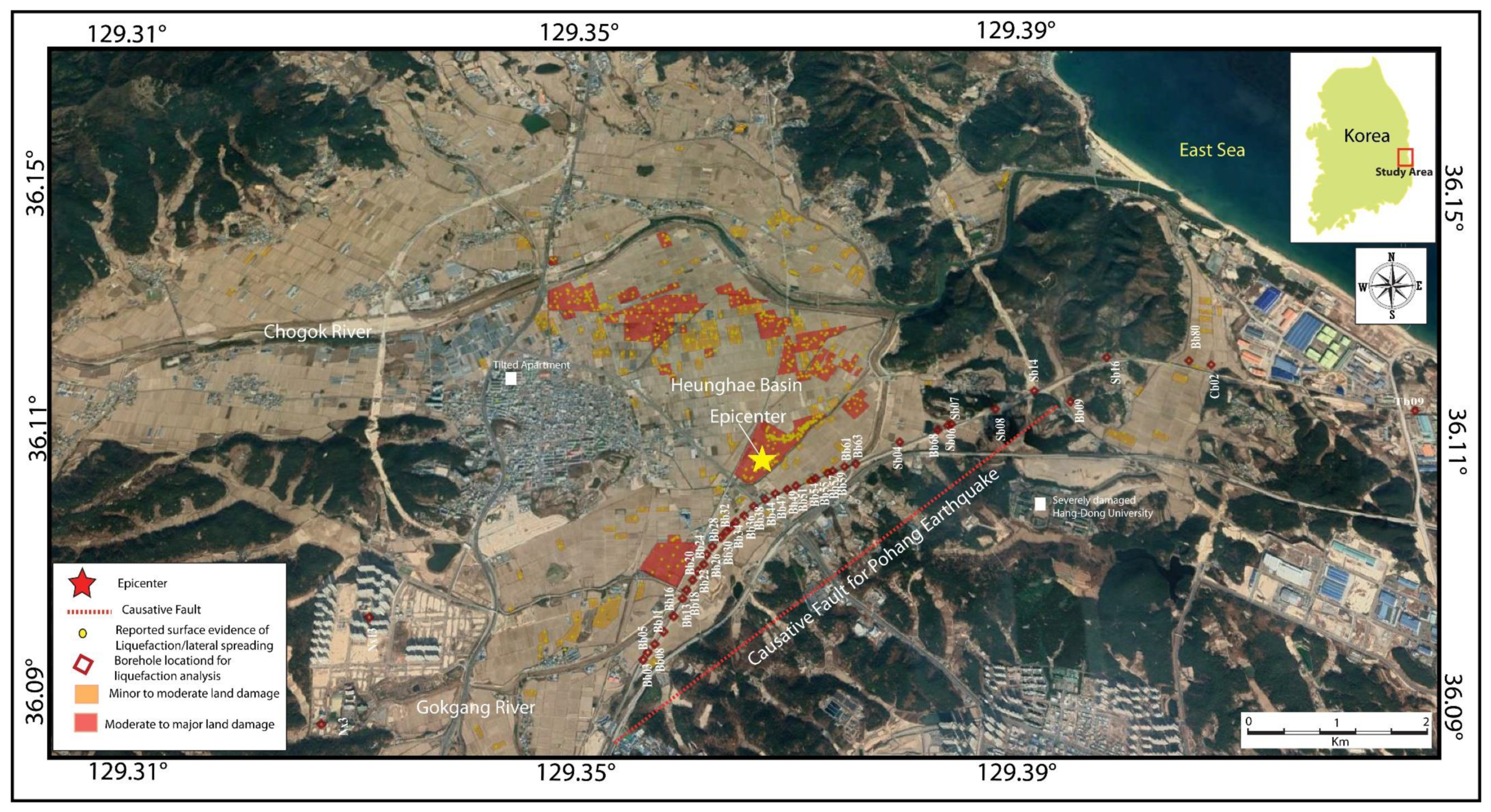

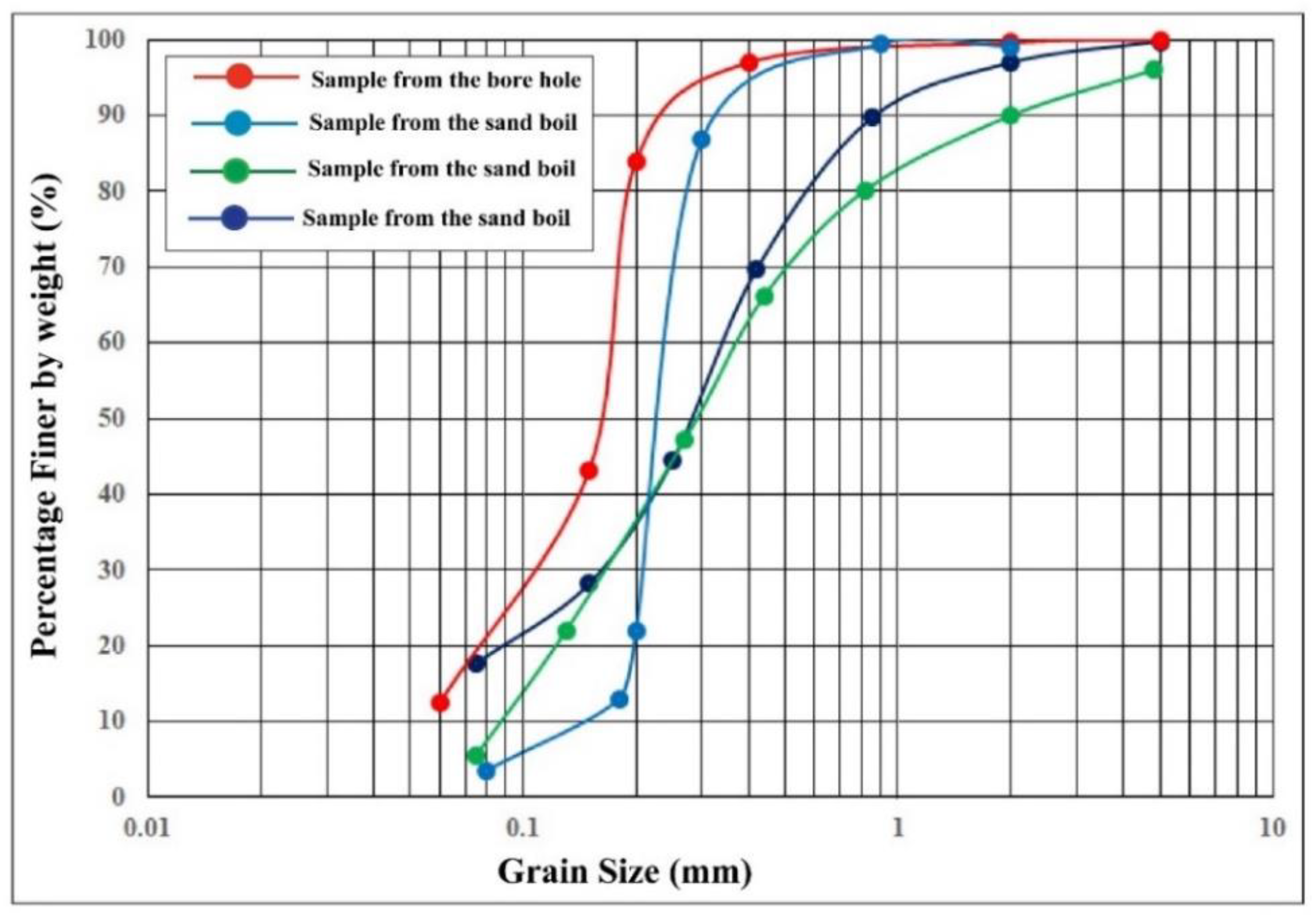
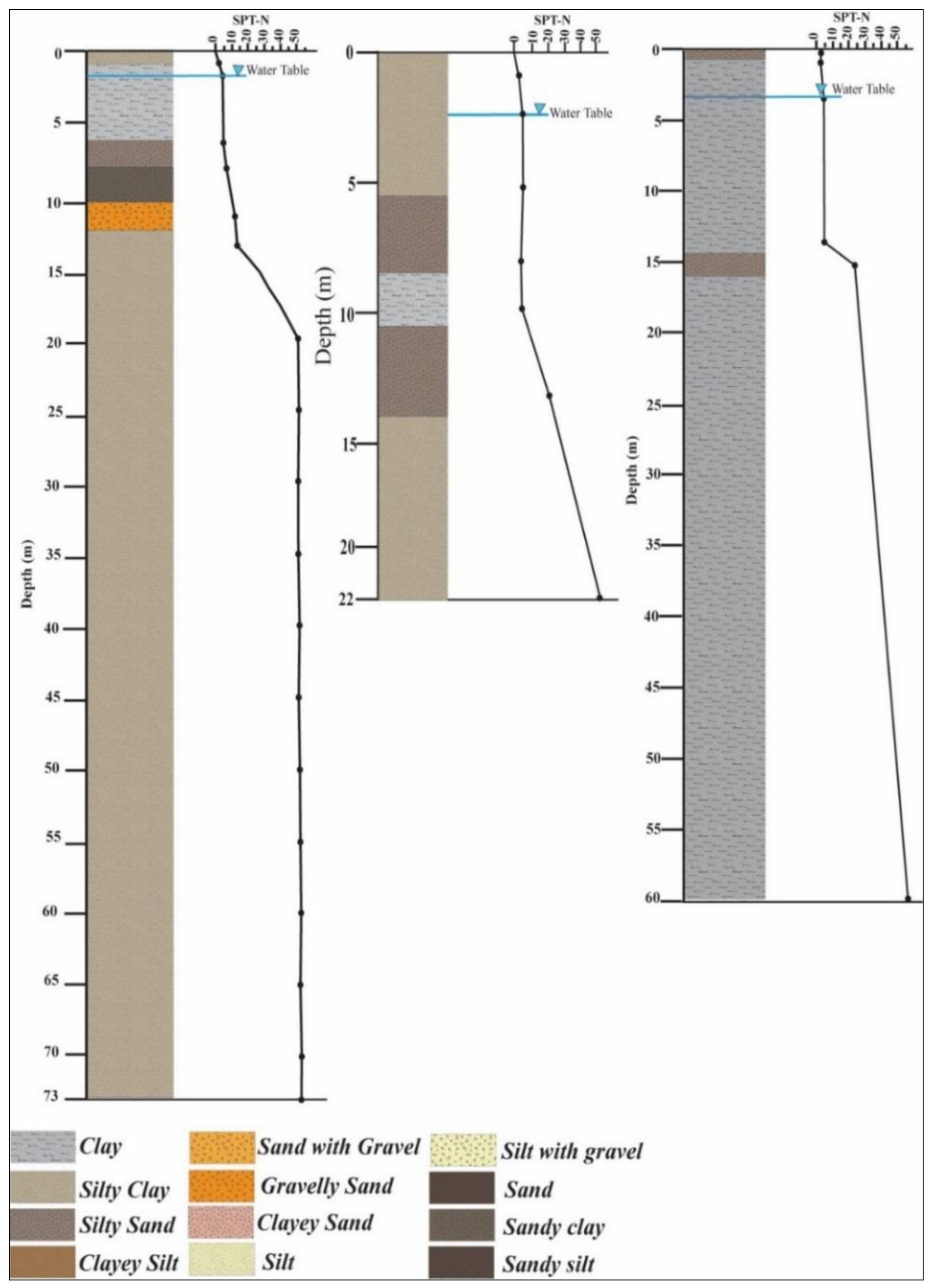
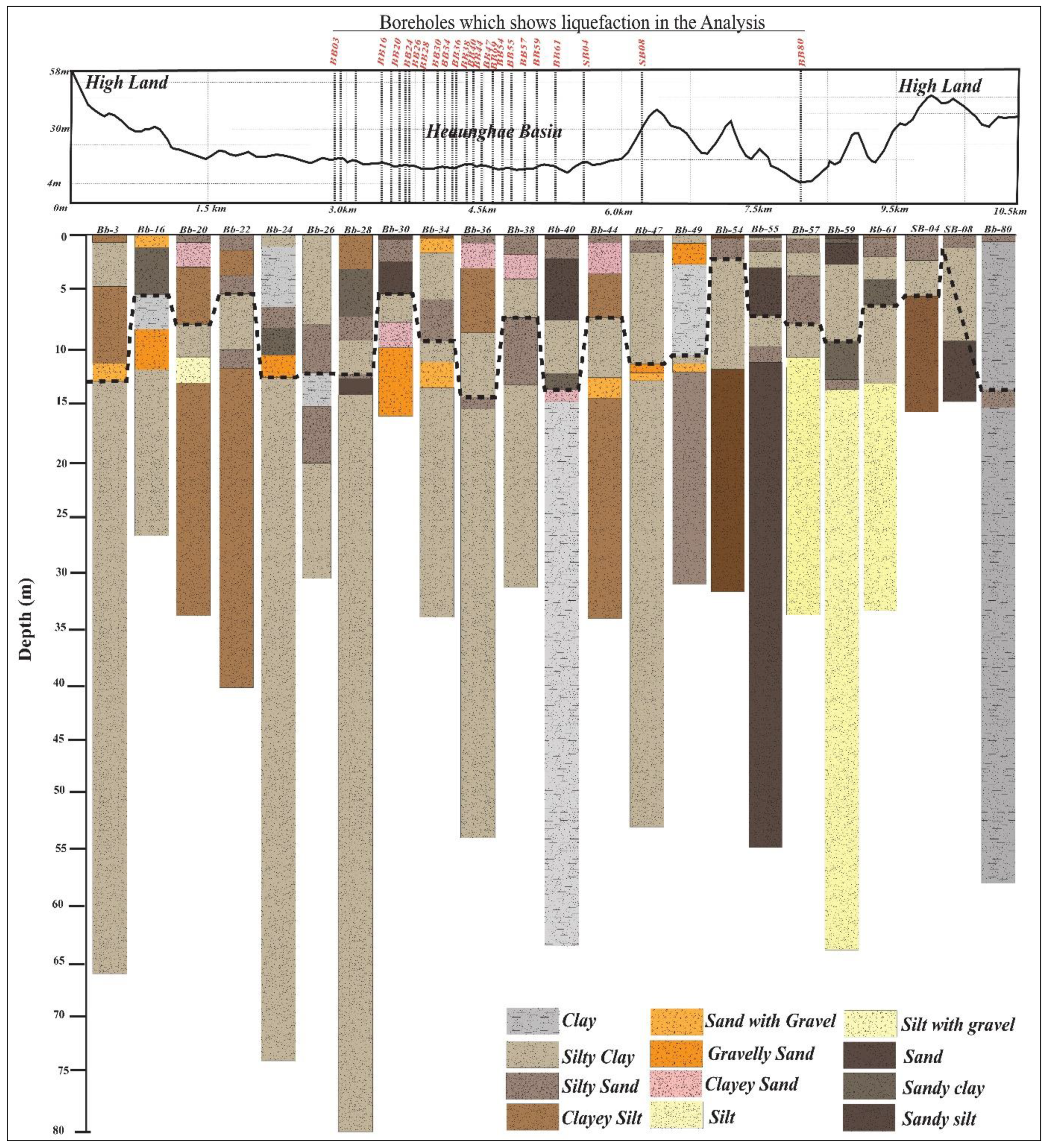
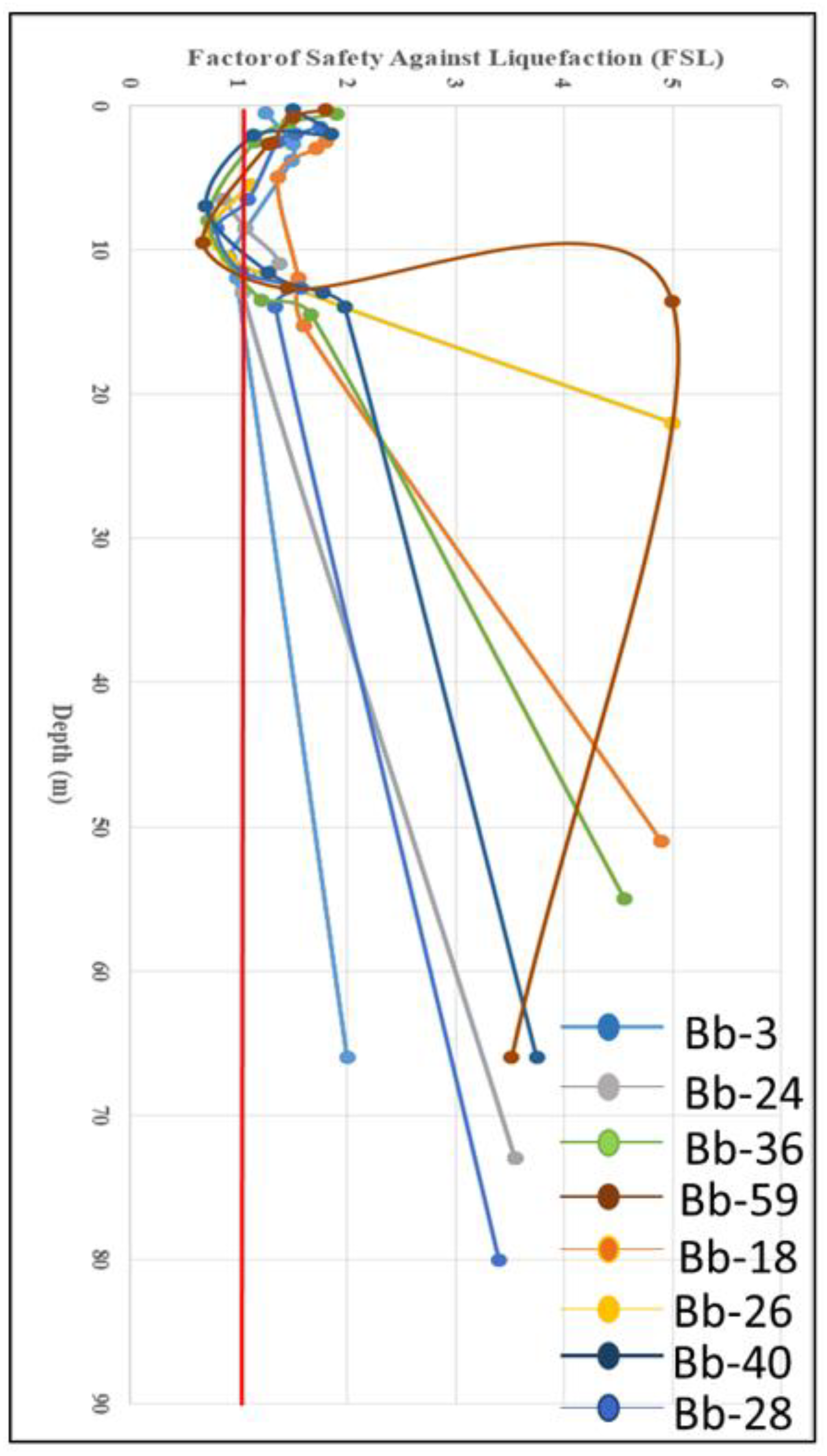
| Local Scale Damage Zone | Descriptions | Land Damage Category |
|---|---|---|
| No Apparent Land Damage | No apparent land damage or signs of liquefaction evidence at the surface | Blue |
| Minor Land Damage | Shaking-induced land damage occurred, but limited to minor cracking, no surface evidence of liquefaction | Green |
| Minor to Moderate Land Damage | Minor to moderate amounts of surface evidence of liquefaction, small cracks from ground oscillation with no vertical displacement, no lateral spreading | Light Orange |
| Moderate Land Damage | Moderate to severe surface evidence of liquefaction, small cracks from ground acceleration, limited lateral spreading | Dark Orange |
| Moderate to Major Land Damage | Moderate to major lateral spreading, extensive liquefaction, large ground cracks | Red |
| Major Land Damage | Extensive lateral spreading, large open ground cracks, extensive liquefaction | Black |
| Depth (m) | SPT-N | Specific Gravity | Unit Weight (kN/m3) | Liquid Limit (LL)% | Plasticity Index (PI) | USCS Soil Type |
|---|---|---|---|---|---|---|
| 0.60 | 4 | 2.68 | 19.60 | 46.8 | 15.7 | ML |
| 1.10 | 4 | 2.68 | 19.60 | 46.8 | 15.7 | ML |
| 2.70 | 4 | 2.68 | 20.50 | 46.8 | 15.7 | ML |
| 8.50 | 2 | 2.69 | 20 | 78.9 | 24 | MH |
| 11.60 | 20 | 2.69 | 18 | 78.9 | 24 | MH |
| 14 | 40 | 2.69 | 22 | 78.9 | 24 | MH |
| 35 | 50 | 2.69 | 20 | 78.9 | 24 | MH |
| Serial No. | ID of the Borehole (Figure 4) | Liquefaction Potential Index (IL) | Post Liquefaction Settlement (cm) |
|---|---|---|---|
| 1 | BB-03 | 3.12 | 30.07 |
| 2 | BB-16 | 12.89 | 20.74 |
| 3 | BB-20 | 12 | 27.10 |
| 4 | BB-22 | 3.98 | 9.63 |
| 5 | BB-24 | 4.44 | 23.31 |
| 6 | BB-26 | 5.52 | 22.85 |
| 7 | BB-28 | 2.34 | 16.59 |
| 8 | BB-30 | 1.46 | 13 |
| 9 | BB-34 | 12.85 | 41.28 |
| 10 | BB-36 | 9.33 | 26.26 |
| 11 | BB-38 | 12.62 | 29.46 |
| 12 | BB-40 | 9.63 | 22.82 |
| 13 | BB-44 | 13.01 | 28.49 |
| 14 | BB-47 | 2.73 | 32.33 |
| 15 | BB-49 | 19.17 | 48.26 |
| 16 | BB-54 | 1.66 | 6.45 |
| 17 | BB-55 | 7.63 | 21.84 |
| 18 | BB-57 | 10.17 | 27.79 |
| 19 | BB-59 | 11.73 | 30.90 |
| 20 | BB-61 | 11.05 | 25.90 |
| 21 | BB-80 | 6.38 | 42.49 |
| 22 | SB-04 | 7.23 | 19.03 |
| 23 | SB-08 | 2.46 | 6.35 |
© 2020 by the authors. Licensee MDPI, Basel, Switzerland. This article is an open access article distributed under the terms and conditions of the Creative Commons Attribution (CC BY) license (http://creativecommons.org/licenses/by/4.0/).
Share and Cite
Naik, S.P.; Gwon, O.; Park, K.; Kim, Y.-S. Land Damage Mapping and Liquefaction Potential Analysis of Soils from the Epicentral Region of 2017 Pohang Mw 5.4 Earthquake, South Korea. Sustainability 2020, 12, 1234. https://doi.org/10.3390/su12031234
Naik SP, Gwon O, Park K, Kim Y-S. Land Damage Mapping and Liquefaction Potential Analysis of Soils from the Epicentral Region of 2017 Pohang Mw 5.4 Earthquake, South Korea. Sustainability. 2020; 12(3):1234. https://doi.org/10.3390/su12031234
Chicago/Turabian StyleNaik, Sambit Prasanajit, Ohsang Gwon, Kiwoong Park, and Young-Seog Kim. 2020. "Land Damage Mapping and Liquefaction Potential Analysis of Soils from the Epicentral Region of 2017 Pohang Mw 5.4 Earthquake, South Korea" Sustainability 12, no. 3: 1234. https://doi.org/10.3390/su12031234
APA StyleNaik, S. P., Gwon, O., Park, K., & Kim, Y.-S. (2020). Land Damage Mapping and Liquefaction Potential Analysis of Soils from the Epicentral Region of 2017 Pohang Mw 5.4 Earthquake, South Korea. Sustainability, 12(3), 1234. https://doi.org/10.3390/su12031234






